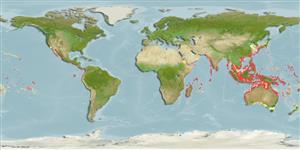Bivalvia |
Ostreida |
Isognomonidae
Environment: milieu / climate zone / depth range / distribution range
Ecology
Benthic; brackish. Tropical
Indo-West Pacific: from East Africa, to Melanesia; north to Japan and south to Indonesia.
Length at first maturity / Size / Weight / Age
Maturity: Lm ? range ? - ? cm Max length : 14.0 cm SHL male/unsexed; (Ref. 348); common length : 10.0 cm SHL male/unsexed; (Ref. 348)
Shell variable, irregularly rounded in outline, with height about equal to length. Dorsal margin straight and relatively short, not expanded posteriorly in a wing-like ear. Anterior margin sharply sinuous dorsally, ventrally strongly convex and extending well forward of umbones. Posterior margin slightly concave, forming an obsolete angulation with the rounded ventral margin. Umbones small, pointing at anterior end of dorsal margin. Outer surface covered with concentric lamellar processes, with very low radial ridge ending at posteroventral angulation. Ligamental area with a dozen transverse grooves. Nacreous area of the inner side of shell surrounded by a broad, non-nacreous margin. Colour: outside of shell horny to purplish brown. Interior nacreous, with a broad dark brown margin.
Attached to rocks and other hard substrates, in marine and brackish water areas (Ref. 348), with sandy and muddy bottoms (Ref. 128042). Common in muddy estuaries and mangrove where it attaches to prop roots. Littoral and shallow subtidal levels (Ref. 348).
Life cycle and mating behavior
Maturity | Reproduction | Spawning | Eggs | Fecundity | Larvae
Members of the class Bivalvia are mostly gonochoric, some are protandric hermaphrodites. Life cycle: Embryos develop into free-swimming trocophore larvae, succeeded by the bivalve veliger, resembling a miniature clam.
Poutiers, J.M. 1998 Bivalves. Acephala, Lamellibranchia, Pelecypoda. p. 123-362. In Carpenter, K. E. and V. H. Niem. 1998. FAO species identification guide for fishery purposes. The living marine resources of the Western Central Pacific. Volume 1. Seaweeds, corals, bivalves, and gastropods. Rome, FAO. (Ref. 348)
IUCN Red List Status
(Ref. 130435: Version 2025-1)
CITES status (Ref. 108899)
Not Evaluated
Not Evaluated
Threat to humans
Harmless
Human uses
| FishSource |
Tools
More information
Trophic EcologyFood items (preys)
Diet composition
Food consumption
Predators
Population dynamicsGrowthMax. ages / sizesLength-weight rel.Length-length rel.Length-frequenciesMass conversionAbundance Life cycleReproductionMaturityFecunditySpawningEggsEgg developmentLarvae PhysiologyOxygen consumption
Human RelatedStamps, coins, misc.
Internet sources
Estimates based on models
Preferred temperature
(Ref.
115969): 23.9 - 29.3, mean 28.4 (based on 3365 cells).
Fishing Vulnerability
Low vulnerability (10 of 100).
Price category
Unknown.
